Today begins the true solo part of my journey. I’ll walk to the Europcar office, pick up my rental and head off to Óbidos and Peniche for the day. After that, relying heavily on the pre-programmed GPS from Portugal Trails, it’s on to the Algarve before I return to the west coast to spend a few days in Lisbon.
Óbidos-si-do.
Óbidos has no connection whatsoever to square dancing and, in truth, the Portuguese pronounce the final consonant more like ‘sh’ than ‘s’ but I can’t resist making even the bad puns. (Today’s title is an even longer stretch of a musical reference.)

So, why, when the main purpose of the trip was spending time in the Algarve on the southern coast of Portugal, would I choose to drive to Óbidos more than 100 kilometers north of Cascais? A look from a distance at the town as one approaches it as seen in the photo above provides at least a hint. In much the same way that Ávila is considered the finest walled city in Spain, the medieval town of Óbidos is likely to claim that title in Portugal.
Even if it didn’t preserve its medieval aura, Óbidos would likely be one of the oldest settled areas in the country. As with much of the entirety of Iberia, there are indications of human habitation dating to the late Paleolithic.
Leaping forward in time there’s some evidence that Celtic tribes or a tribe called Lusitanians built the first settlement in the immediate vicinity of Óbidos. The Lusitanians and Celts appear to have gotten on reasonably well because they joined forces in a failed effort to stave off Roman conquest. The Visigoths followed the Romans and ruled for about two centuries until they were displaced by the Moors who, in the early eighth century, began construction of the fortifications we can admire today.
The moors controlled the area for more than five centuries until Afonso Henriques, who became known as Afonso o Conquistador,

[Illustration from Wikimedia Commons – Public Domain.]
first secured his country’s independence from Leon in 1139 and then led his armies to drive out the Moors from the west coast in 1148 becoming Portugal’s first king in the process.
In 1282 when 10 year old Elizabeth of Aragon was betrothed to King Dinis (they married in 1288), he began a centuries long tradition of making a gift of the town of Óbidos to the queen.
(Elizabeth of Aragon was elevated to sainthood by Pope Urban VIII in 1625. Both Elizabeth of Aragon and her great aunt, Elizabeth of Hungary, who was also canonized, were reported to have performed a “miracle of the roses.” The stories about the two women were nearly identical and follow this general plot line:
Both were pious women who were forbidden by their unfaithful husbands to give food or aid to the poor. Both hid bread under some article of clothing and both encountered their husbands on their way to deliver the food sometime in a cold winter month. The husbands asked what they were carrying and both women answered roses. Of course, in both cases, the bread transformed into roses when the women revealed what they had hidden.)
One queen who made a tangibly significant contribution to Óbidos was Queen Catherine who used her personal funds to build the town’s aqueduct in 1573 near the end of her husband’s (Sebastián the First) reign.
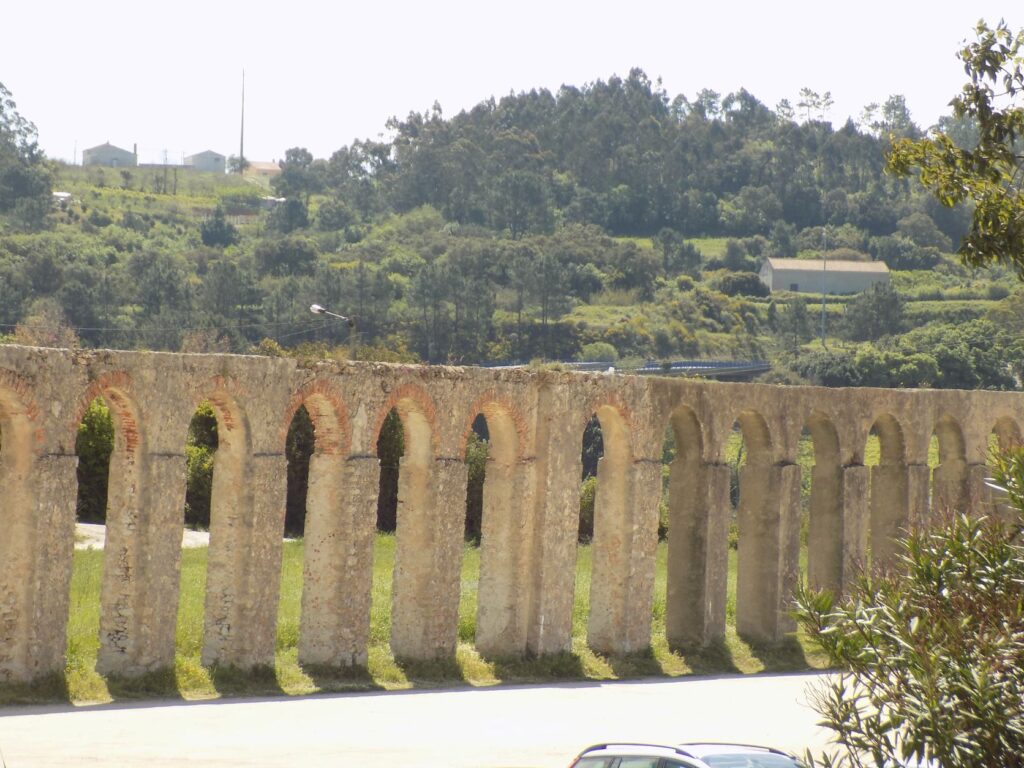
The aqueduct is nearly 3km long and it delivered water to two fountains in the town.
Although some residents and delivery people are allowed to drive within the city walls, day tourists are not. If you park on the lot nearest the city gate, your first experience entering the town is, in a sense, medieval.
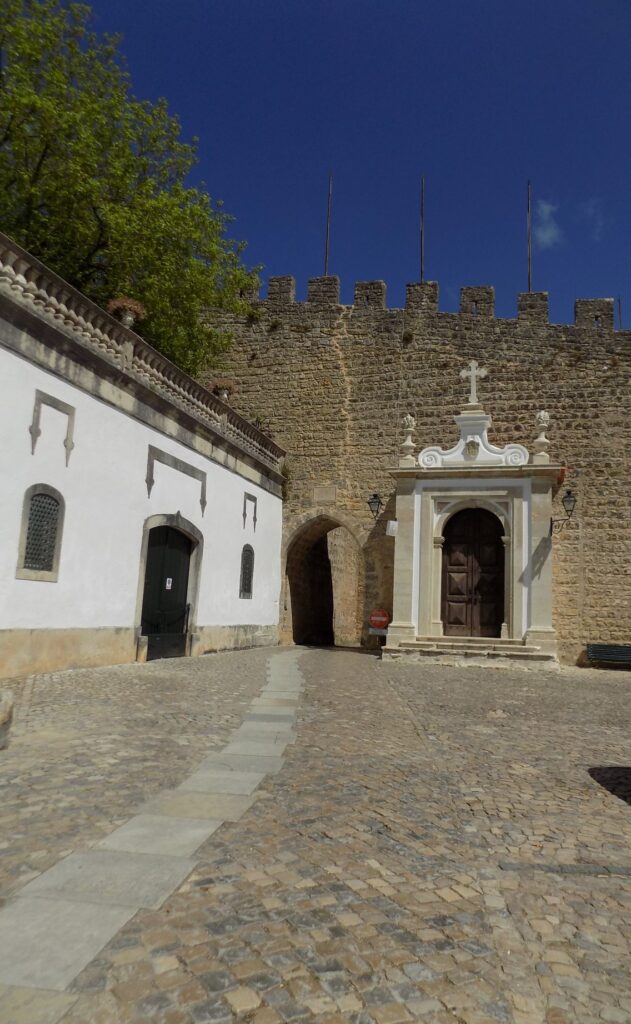
Built in 1380, the double door and bent elbow shape are typical of medieval defenses.
Once inside the first door, visitors are greeted by an area decorated by the distinctive Portuguese blue tiles known as azulejos. These were installed in 1740. The balcony served as an oratory with the panels depicting the Passion of the Christ.
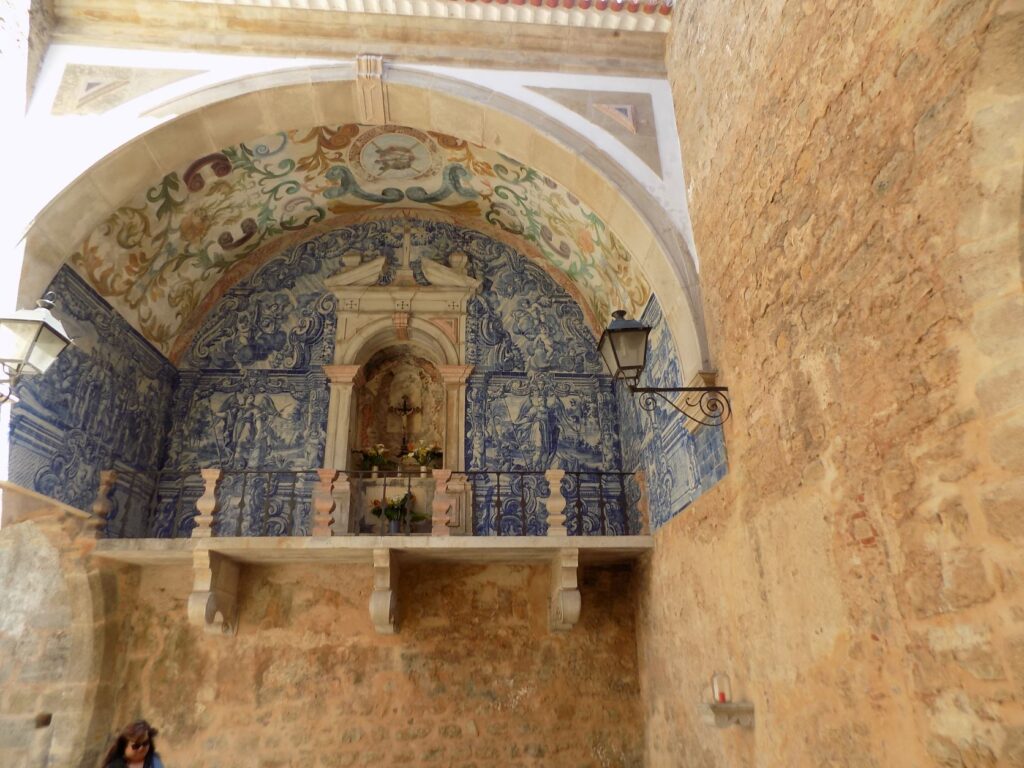
Exit the gate and on your immediate left is a stairway with this sign.
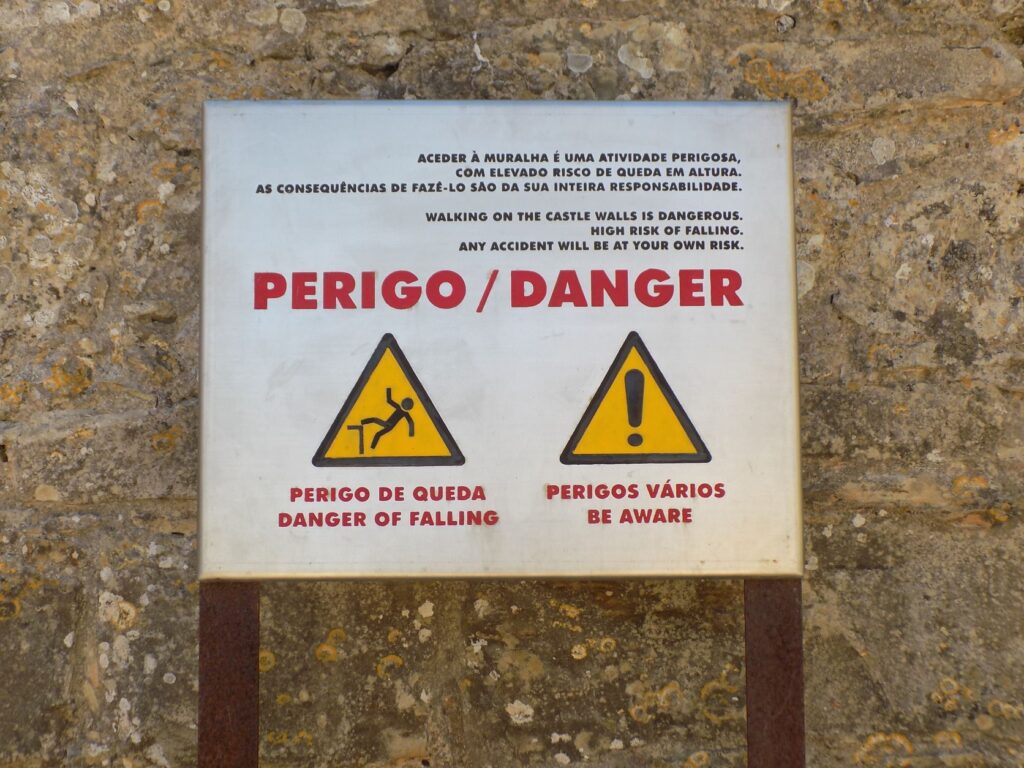
Still, despite the warning, one of the attractions of Óbidos, is the opportunity to walk along the castle wall – if you dare – keeping in mind that this excursion requires caution at the very least.
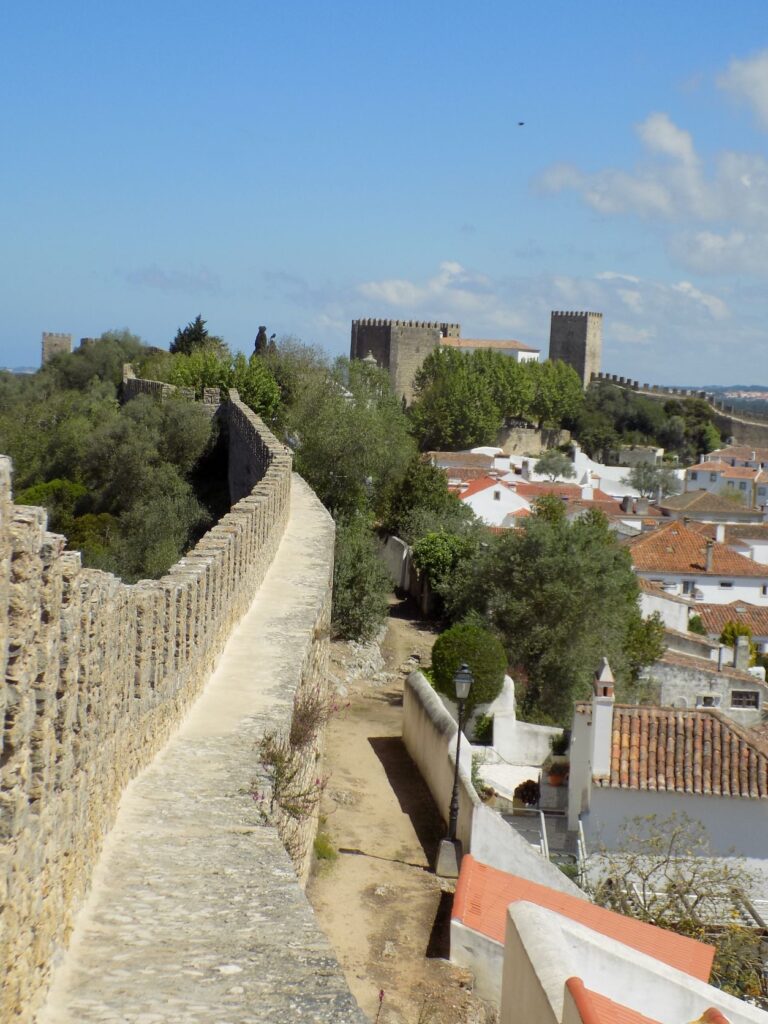
The literary capital of Portugal?
Óbidos has become something of a tourist mecca. Wandering its cobblestone streets will lead you past numerous restaurants, cafés, ginjinha bars, and shops and shops and shops of every description. But turn down one street in particular – R. Dom João de Ornelas, and you can spot the literary man óbidos hotel.
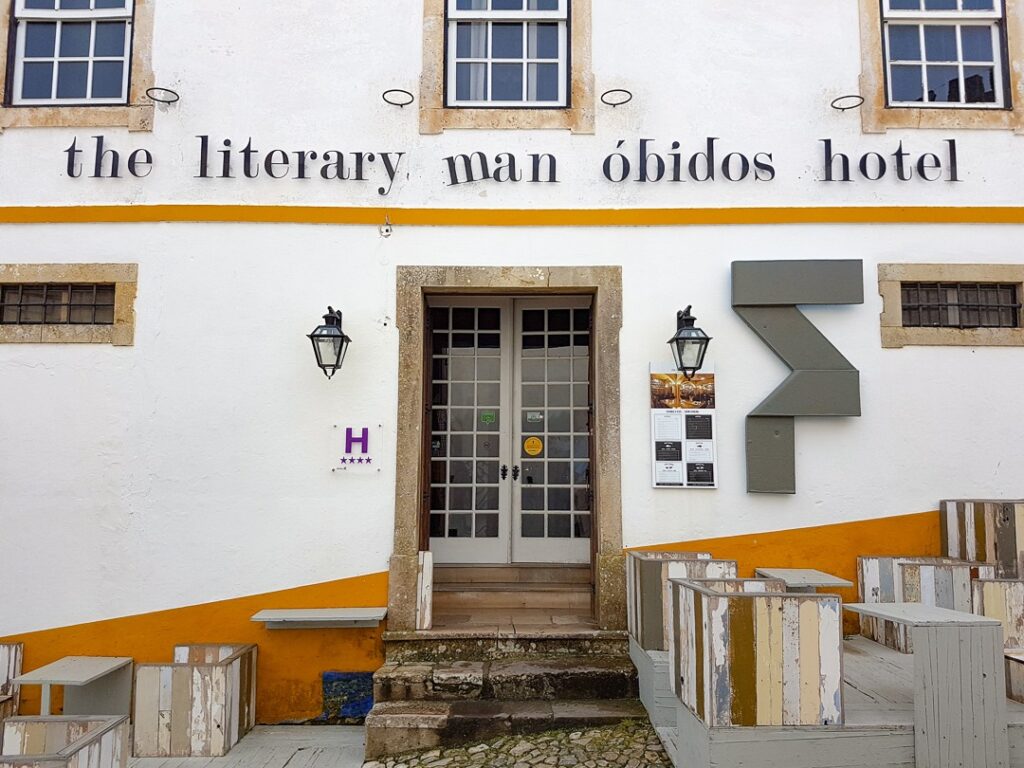
Inside its walls this town has a population of a bit more than 3,000. The broader municipality has a bit less than 12,000. Yet in 2015 UNESCO named it a city of literature placing it alongside cities such as Barcelona and Dublin. Walk inside the Literary Man Hotel and the scene looks like this:.

[Photo from The Literary Man Hotel website].
The largest literary hotel in the world holds more than 65,000 books throughout its hallways, rooms, restaurant, and bar. Elsewhere, although you wouldn’t describe them as traditional booksellers, you’ll find at least 10 noteworthy bookstores such as the Livraria do Mercado on the main shopping street R. Direita. Yes, you can buy fresh fruit and vegetables (mainly, if not exclusively organic) here but there are probably more books for sale than foodstuffs.
Or there’s the Livraria de Santiago inside a 12th century church. Or you can visit the Livraria da Adega hidden in an old wine cellar. Sit down, have a glass of port and read. Now you have an idea why I wanted to visit Óbidos.
Not giving off an American vibe.
The morning had passed into afternoon more quickly than I’d reckoned and I wanted to stop and spend a few hours in Peniche before I returned to Cascais so I spotted a relatively uncrowded restaurant and ducked in. I sat down at a table next to two women who started a conversation with me when they heard me ask the server for an English menu. Their conversation starter was that they were surprised to hear my American accent because they liked to guess people’s nationalities and I didn’t give off “an American vibe.”
Helen and Elizabeth met in New Haven more than 50 years ago when one was attending Yale and have remained lifelong friends. They were traveling together/alone because both their husbands were no longer able to travel with them but the couples had made annual trips which, until recently, were focused on hiking – a pastime they have in common with my sister and her husband.
The conversation drifted from topic to topic as conversations do and I learned that Helen’s daughter married a Sephardic Jew who was able to prove his heritage and thus was granted Portuguese citizenship based on a 2015 law. They now live in Setúbal an exurb about 50 kilometers south of Lisbon.
Our conversation delayed my departure even more and, although Peniche was only about half an hour’s drive, I spent barely two hours there wandering about. I wanted to visit Peniche because while my focus was on the Algarve, I thought this was at the northern extreme of coastal cities in Portugal that I might consider as a place to settle.
Maybe I caught the town on a bad day or maybe it was too prosaic a place to visit after spending most of the day in Óbidos but I was unimpressed with the general vibe and not unhappy that my time was even shorter than the short time I’d planned to spend there. There was, however, an interesting sculpture outside a restaurant that earned one of the few photos I took in Peniche.
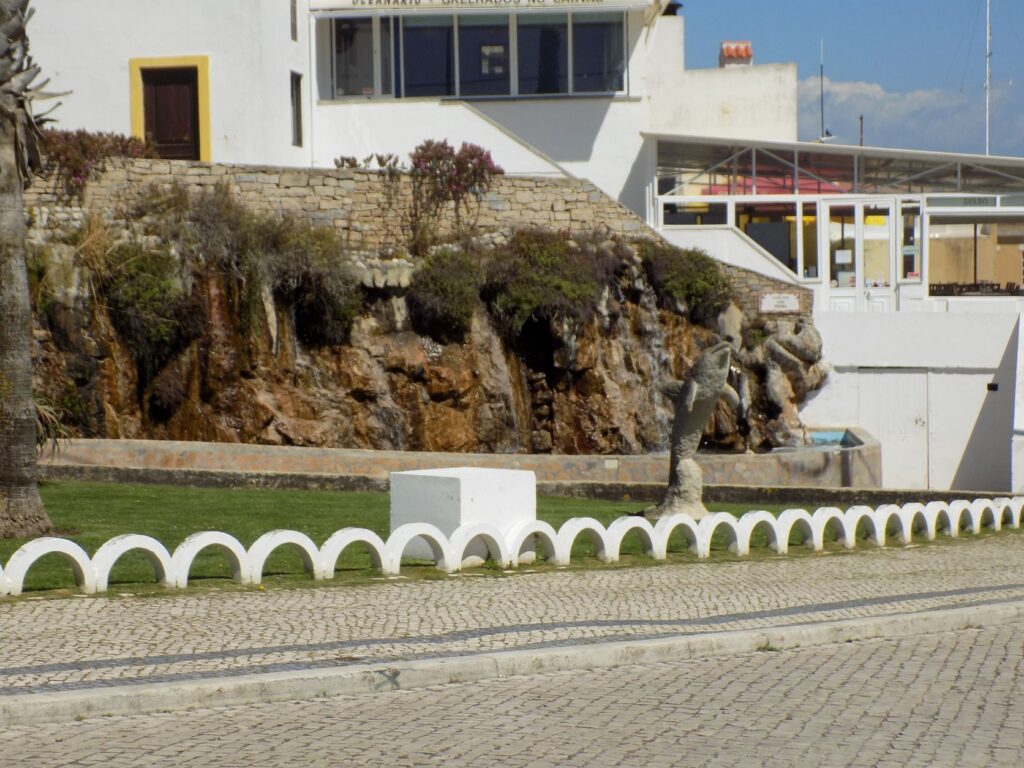
On my arrival in Cascais, I parked my car in the marina garage near the hotel and set off on another circuitous walk before landing for dinner at Pizzeria Il Siciliano where, I’d been told, I’d find the best pizza in the city. I ordered a salad, a plain pizza , and a beer. (Sagres again. I’d tried the other non-craft brew called Super Bock and decided that Sagres was the better choice – at least for me.) When they brought the pizza to my table, both the look and the taste immediately made me think of my buddy John F back in Maryland. This was his kind of pizza with a thin crust, light on the cheese, and a rich tomato sauce but most important, it was well-done and a bit charred around the edges.
As I walked back to the hotel, I began to think about Zicomo. I hadn’t received any update from the vet and tried to frame it in my mind as no news equaling good news.
Here are the rest of the photos from the day. Tomorrow, I set off for the Algarve and the town of Sagres.